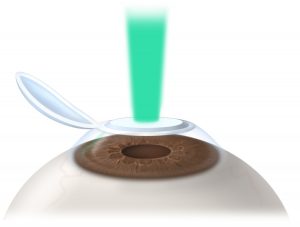

Photorefractive Keratectomy (PRK) is a surgical procedure effective in correcting nearsightedness, farsightedness, and astigmatism. After extensive analysis of the eye, surgeons and technicians work together to program an excimer laser to vaporize away microscopic layers of corneal tissue. With a modified curvature, focusing problems are reduced or eliminated.
The excimer laser is a unique type of cold laser that does not burn or cut tissue. Instead, it gently breaks the molecular bonds between cells so that controlled amounts of tissue can be literally vaporized away, one microscopic layer at a time. The tissue can be removed from the surface of the cornea, as in the PRK procedure, or from the interior of the cornea after a thin flap of surface tissue has been lifted, as in the LASIK procedure. When using PRK to correct nearsightedness, the curvature of the cornea is reduced. In most cases, only 10 to 15% of the thickness of the cornea is removed. Eyes heal impressively well, and the results are very satisfactory, with most people achieving normal or near-normal natural vision. Immediate recovery time and time off from work is three to five days. You will need a driver at this time.
PRK was first performed in Berlin, Germany in 1987. Since that time, over 8 million people around the world have found new visual freedom as a result of laser surgery.
